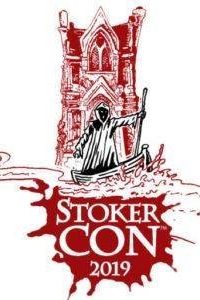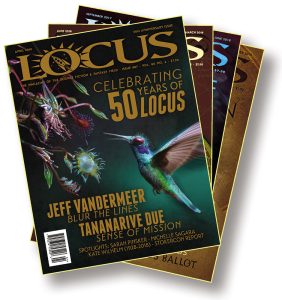Saving the World Through Science Fiction, Unless We’re Too Late by Gary K. Wolfe
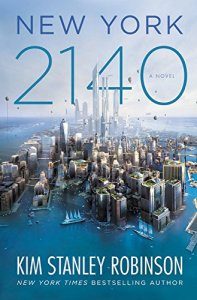 [Editor’s note: part of our 2017 year-in-review essay series from the February 2018 issue of Locus]
[Editor’s note: part of our 2017 year-in-review essay series from the February 2018 issue of Locus]
According to Barnes & Noble’s year-end summary, if we set aside J.K. Rowling and Rick Riordan, the bestselling genre-related novel of 2017 was Margaret Atwood’s The Handmaid’s Tale, followed a few slots later by Stephen King’s It – novels originally published in 1985 and 1986, respectively. Amazon’s list adds Orwell’s 1984 (from way back in 1948) and, farther down on the list, Bradbury’s Fahrenheit 451 from 1953. Some of this simply reflects the marketing clout of TV and movie adaptations, of course, but that doesn’t explain the Orwell and Bradbury titles. It’s as though people, at least in the US, were looking for guidebooks to the new era (Octavia E. Butler’s Parable series also got a lot of social media mentions), and finding that some classic SFnal nightmares most clearly reflected their anxieties. Looked at from a slightly different angle, it’s as though Americans, having been fascinated for years by thuggish oligarchical dystopias, decided to actually try one out. Or, it’s like test-driving the most unsafe, inefficient, gas-guzzling, pollution-spewing vehicle you can find and then discovering that you’ve inadvertently already paid for it.
Of course, we’ll need to wait until later this year and into next before we’ll get a sense what real Trump-era SF and fantasy looks like, but even without the Trump effect there are signs of a shift in tone, from admonition to resignation in some key thematic areas. Some of the most important environmental novels of the year came across less as cautionary tales than as fables, or even comedies, of survival. Kim Stanley Robinson, whose Science in the Capitol Trilogy a decade ago was a policy-specific model of awful-warning SF, gave us New York 2140, undoubtedly one of the major novels of the year (and one of the best). The novel may have exaggerated the degree to which coastal flooding will inundate lower Manhattan, but its focus is not so much on how to prevent catastrophe as on strategies to cope with it (though Robinson’s critiques of capitalism are as blistering as ever, and his varied cast of characters as compelling). By the same token, Paul McAuley’s equally complex and character-based Austral may exaggerate the ways in which Antarctica becomes the new frontier for settlements in a world in which climate mitigation has failed, but the failure of such efforts at mitigation seems a foregone conclusion.
Paolo Bacigalupi’s Tool of War concluded the trilogy that began with Shipbreaker in 2010, continuing to expand the geographical reach of his epic to include much of the Eastern seaboard, but focusing more on the predations of post-government corporate brutality, with the augmented warrior Tool emerging more and more as a tragic Frankenstein figure. James Bradley’s Clade, which first appeared in Australia in 2015, but only showed up last year in the US, expanded the scope yet again to include much of the globe, in a strangely moving family saga that stretches deep into a vastly diminished future. None of these novels bother to preach the familiar “if this goes on” warning so much as suggest that this has already gone to the point of irrevocability, and the world as we know it is already deep in the toaster. The same might be said of Cat Sparks’s debut novel Lotus Blue, which presents a future Australia violent enough to make the Mad Max films look like pastorals. Even novels which only tangentially touch upon this theme on the way to their main concerns, such as Jeff VanderMeer’s surrealistic dystopia Borne or John Crowley’s epic fantasy Ka: Dar Oakley in the Ruin of Ymr (more about that in a moment) share this tone of grim inevitability, as Crowley’s title suggests (Ymr is the crow name for the human world).
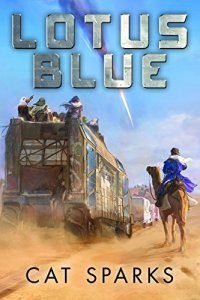 Given this likely state of the Earth, it shouldn’t be surprising that two of the year’s more provocative and entertaining novels should be set on the Moon. The Moon and the Other, John Kessel’s first novel in 20 years, takes place mostly in two contrasting lunar colonies that we first glimpsed in a series of award-winning short stories, and raises issues of gender attitudes and governance that recall some of the classic heterotopias of Le Guin and Delany. Ian McDonald’s Luna: Wolf Moon continues his enthralling corporate war soap opera set on a virtually lawless moon (contract law is everything) and, like Kessel, offers some stirring, old-fashioned hard-SF hairbreadth survival adventures as well.
Given this likely state of the Earth, it shouldn’t be surprising that two of the year’s more provocative and entertaining novels should be set on the Moon. The Moon and the Other, John Kessel’s first novel in 20 years, takes place mostly in two contrasting lunar colonies that we first glimpsed in a series of award-winning short stories, and raises issues of gender attitudes and governance that recall some of the classic heterotopias of Le Guin and Delany. Ian McDonald’s Luna: Wolf Moon continues his enthralling corporate war soap opera set on a virtually lawless moon (contract law is everything) and, like Kessel, offers some stirring, old-fashioned hard-SF hairbreadth survival adventures as well.
As politically and socially sophisticated as these novels are, a good part of their appeal comes from their skilled deployment of those familiar adventure tropes, and much the same can be said of the most impressive debut SF novel of the year, Annalee Newitz’s Autonomous. Like Bacigalupi and McDonald, she sees a corporatized world in which the most powerful player is an “International Property Coalition,” and the renegade protagonist being pursued by them is a freelance pirate (she even has her own submarine!) whose specialty is reverse engineering proprietary drugs to make them available to those who can’t afford extortionate big pharma prices. The globetrotting pursuit-and-evade plot is satisfying at the thriller level, but Newitz also uses it to explore, in very contemporary AI terms, the classic SF puzzle of a robot trying to learn what humans are all about, while trying to earn autonomy. Another important debut was Rivers Solomon’s An Unkindness of Ghosts, which also begins with a classic SF premise: the generation starship which has evolved into its own stratified society, in this case one which has uncomfortable parallels with the antebellum South. An elite managerial class enjoys a comfortable life above, while darker skinned proletarians labor in the underheated, resource-poor lower decks. Solomon’s appealing and unusual protagonist tries to serve as a kind of informal link between the two worlds, and the insightful development of her and other characters, together with Solomon’s unflinching social realism, moves the novel well beyond the simple allegory it may at first seem. Of the other first novels I read – in addition to these two, the Cat Sparks novel, and those by Goss, Saunders, and Tidbeck discussed below – was Sam J. Miller’s The Art of Starving, which deals with the difficult issue of eating disorders in a refreshingly candid voice, and with a substantially original fantasy conceit.
Kameron Hurley’s The Stars Are Legion wasn’t a debut novel, but represented her first straight-on space opera, and again it draws on familiar SF tropes – in this case, a harrowing quest through some truly nightmare planetary landscapes, counterpointed by another character’s shrewd navigation of interplanetary politics. Apart from its powerful SF/horror imagery, it’s distinguished among space operas by having no male characters at all. Nnedi Okorafor’s Binti series, which also began as an intriguing space opera with some gruesome horror elements when that novella appeared in 2015, brought its Himba protagonist back to Earth in Binti: Home (the trilogy concluded last month with Binti: The Night Masquerade), expanding the story by introducing some homegrown mysteries and continuing Okorafor’s exploration of the plight of various kinds of outsiders (Binti herself, her alien companion, the mysterious Desert People), which may be her most persistent theme, was also reflected in the other sequel she published during the year, Akata Warrior, the further adventures into African mythology of its American-raised Nigerian teenager. With several guest of honor appearances, a TED talk, and a new series of Black Panther comics debuting at the end of the year, Okorafor seems to have had one of the most productive years of any writer in the field, further cementing her emerging role as a worldwide SF presence.
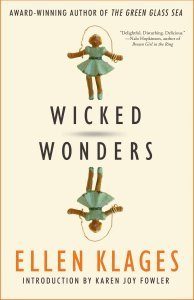 Okorafor is one of a number of writers continuing to explore the margins between SF and fantasy and, though often unclassifiable in traditional genre terms, such novels can make for delightfully intriguing reading. Two that struck me as especially provocative were Karin Tidbeck’s Amatka (originally published in Sweden in 2012, but now translated), set in an oddly constricted dystopia with some post-apocalyptic SF elements, but built around the wildly imaginative conceit of a world whose reality is sustained directly by language (you have to keep reminding your typewriter that it’s a typewriter, for example, lest it start dissolving). Nina Allan’s The Rift questions the relationship between language and reality in a different way: a sister suddenly returns after disappearing years earlier, claiming to have spent the time on a distant planet whose history, mythology, and geography are presented in convincing detail, sometimes in documents that may or may not be part of the sister’s story. Other documents presented as part of the narrative raise even more questions, barely leaving us the option of reading the whole thing as a mainstream psychological mystery. The second novel in Aliette de Bodard’s Dominion of the Fallen series, The House of Binding Thorns, combines the SF convention of alternate history with a kind of secular theological epic featuring competing houses of fallen angels, but moves its important postcolonial themes more to center stage, considerably expanding the moral scope of this promising series.
Okorafor is one of a number of writers continuing to explore the margins between SF and fantasy and, though often unclassifiable in traditional genre terms, such novels can make for delightfully intriguing reading. Two that struck me as especially provocative were Karin Tidbeck’s Amatka (originally published in Sweden in 2012, but now translated), set in an oddly constricted dystopia with some post-apocalyptic SF elements, but built around the wildly imaginative conceit of a world whose reality is sustained directly by language (you have to keep reminding your typewriter that it’s a typewriter, for example, lest it start dissolving). Nina Allan’s The Rift questions the relationship between language and reality in a different way: a sister suddenly returns after disappearing years earlier, claiming to have spent the time on a distant planet whose history, mythology, and geography are presented in convincing detail, sometimes in documents that may or may not be part of the sister’s story. Other documents presented as part of the narrative raise even more questions, barely leaving us the option of reading the whole thing as a mainstream psychological mystery. The second novel in Aliette de Bodard’s Dominion of the Fallen series, The House of Binding Thorns, combines the SF convention of alternate history with a kind of secular theological epic featuring competing houses of fallen angels, but moves its important postcolonial themes more to center stage, considerably expanding the moral scope of this promising series.
That brings us to the question of the increasingly fluid relations between genre and mainstream fiction. The most interesting novels in this shadow category include one of the most widely acclaimed novels of the year, George Saunders’s Man Booker winning Lincoln in the Bardo, which, once you get past the bold experiment of a point of view shared among over 600 voices (many with only a single line or two) is essentially a ghost story set in a cemetery, and one that for the most part honors ghost story conventions rather than merely treating them as convenient metaphors. Victor LaValle, who has already demonstrated his astute awareness of genre materials with stories such as 2016’s award-winning The Ballad of Black Tom, took that awareness several steps further with The Changeling, which begins as a very New York-centric mystery and for much of its length reads as mainstream, until it starts opening up in deeply unsettling ways that make no apology for the fantastic and folkloric content. Paul La Farge’s remarkable The Night Ocean is so embedded in pulp lore and genre history that its core, a story about the relationship between H.P. Lovecraft and Robert Barlow, is wrapped in so many layers of unreliable narration that the question of whether it crosses the line into material fantasy is almost irrelevant, although its deft sketches of everyone from the 1939 Worldcon attendees to a young Ursula Le Guin should be irresistible to most genre readers. Finally, Daryl Gregory may have grown up in our corner of the closet, but his Spoonbenders seemed to receive as much if not more attention from the mainstream press as the genre press, despite the fact that his wacky family of would-be frauds and hucksters actually display various psychic powers, which are crucial to his plot. The deeply affectionate family dynamic he outlines, along with his acute sense of character and place, may account for its wide reception as a kind of twisted family comedy.
Moving over to the clearly fantasy side of the ledger, the year’s outstanding novel was John Crowley’s Ka: Dar Oakley in the Ruins of Ymr, a historical epic that covers thousands of years of European and North American history through the eyes of the immortal crow of the title, as told to a human narrator living in a diminished and disease-ridden future. Crow’s various alliances and rivalries in both the world of humans and the world of beasts, as well as the stories of his rivals, allies, and witnesses (including a neolithic young girl hunter, a medieval priest, and an Emily Dickinson-style Civil War era poet), are all realized with Crowley’s characteristically acute and humane observation and precise, evocative style.
Historical settings are of course a staple of fantasy, and a fascinating subset of this are novels which play in the fields of earlier classics, at once commenting on them from new perspectives, such as gender or race, while taking full advantage of the power of their storytelling. The most wide-ranging and entertaining of these was Theodora Goss’s The Strange Case of the Alchemist’s Daughter, a Victorian thriller which drew its main characters from Shelley, Stevenson, Wells, Hawthorne, and Stoker, while inviting us to reconsider their source stories from perspectives of gender and power. Molly Tanzer’s Creatures of Will and Temper drew mainly on Oscar Wilde’s The Picture of Dorian Gray, again gender-flipping some of the main characters, but at the same time raising issues of art, decadence, class, and power, and framing it all in a character-driven tale of two very different sisters. Kij Johnson managed something even trickier with The River Bank, a sequel of sorts to Kenneth Grahame’s The Wind in the Willows, which effortlessly replicates the charming tone of the original while casting light on issues of gender, class, and power that were politely overlooked there. Even SF’s master satirist James Morrow riffed on a source text – in this case a classic expressionist movie – in his characteristically acerbic and often hilarious novella The Asylum of Dr. Caligari, although the focus isn’t on the film so much as on the early days of modernist art.
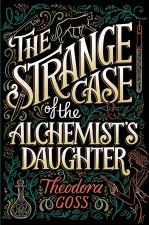 The Morrow novella is a reminder of the narrative form that in many ways came into its own in 2017, the novella (aren’t these transitions seamless?). The novella is nothing new, of course; decades ago you could find editors such as Robert Silverberg or Groff Conklin making a case that it’s a particularly well-suited length for science fiction and fantasy, but novellas often pose a problem for anthologists because they’re too long, and for book publishers because they’re too short. In recent years, several publishers – Tor.com, Tachyon, Subterranean, PS – have demonstrated there’s a respectable market for standalone novellas, both online and in print. Early in the year, Ellen Klages produced her finest work for adults, Passing Strange, a seamless mix of meticulous San Francisco history, pulp art, queer romance, and magical women, following this later in the year with her delightful second collection, Wicked Wonders. Jeffrey Ford brought his acute sense of character and place to the haunted house tale in The Twilight Pariah, while Peter Beagle continued a string of subtly magical novellas with In Calabria. The most thoroughly enjoyable space opera novella was almost certainly Dave Hutchinson’s Acadie, part slapstick, part celebration of classic SF, and partly solid idea-driven SF with some acute social commentary. K.J. Parker offered another of his hilariously cynical quasi-historical fantasies of war and politics in Mightier than the Sword. And, as noted earlier, Nnedi Okorafor continued her series of three SF novellas with Binti: Home.
The Morrow novella is a reminder of the narrative form that in many ways came into its own in 2017, the novella (aren’t these transitions seamless?). The novella is nothing new, of course; decades ago you could find editors such as Robert Silverberg or Groff Conklin making a case that it’s a particularly well-suited length for science fiction and fantasy, but novellas often pose a problem for anthologists because they’re too long, and for book publishers because they’re too short. In recent years, several publishers – Tor.com, Tachyon, Subterranean, PS – have demonstrated there’s a respectable market for standalone novellas, both online and in print. Early in the year, Ellen Klages produced her finest work for adults, Passing Strange, a seamless mix of meticulous San Francisco history, pulp art, queer romance, and magical women, following this later in the year with her delightful second collection, Wicked Wonders. Jeffrey Ford brought his acute sense of character and place to the haunted house tale in The Twilight Pariah, while Peter Beagle continued a string of subtly magical novellas with In Calabria. The most thoroughly enjoyable space opera novella was almost certainly Dave Hutchinson’s Acadie, part slapstick, part celebration of classic SF, and partly solid idea-driven SF with some acute social commentary. K.J. Parker offered another of his hilariously cynical quasi-historical fantasies of war and politics in Mightier than the Sword. And, as noted earlier, Nnedi Okorafor continued her series of three SF novellas with Binti: Home.
Another of the strongest novellas of the year, Christopher Rowe’s “Border State”, is a prequel to his acclaimed “The Voluntary State” and is organized around a bicycle race in the nano-drenched mid-South landscape of that earlier story. It appeared originally in Rowe’s first story collection, Telling the Map, which provided an overview of this brilliant but not very prolific writer, and was one of the best collections of the year. Similarly, Sofia Samatar’s first collection Tender, is also an overview of Samatar’s beautiful style and eccentric imagination, and features a new novella, “Fallow”, which, set on an unforgiving colony world and characteristically embedding other deeply humane stories, is her strongest venture into SF so far.
Those collections by Klages, Rowe, and Samatar were among the most noteworthy of the year, and to them we should add Jane Yolen’s The Emerald Circus, her first adult collection in 17 years, in which she revisits classic stories and writers from Hans Christian Andersen to Peter Pan (in her classic “Lost Girls”), Emily Dickinson, and even Geoffrey of Monmouth. Peter Beagle, in his collection The Overneath, revisits some of his past hits, with two stories about Schmendrick, others about different varieties of unicorns, and one from the world of The Innkeeper’s Song, though probably the best story is the original fairy tale “The Queen Who Could Not Walk”. No doubt the most experimental collection of the year was M. John Harrison’s You Should Come With Me Now: Stories of Ghosts, in which the “ghosts” of the title cover a wide variety of kinds of fiction, from snippet-length parodies of space operas or fantasy series to powerful but enigmatic stories like “Entertaining Angels Unawares”, “Yummie”, and the fine Autotelia stories “In Autotelia” and “Cave and Julia”. Finally, PM Press continued its series of sampler size collections with Elizabeth Hand’s Fire. and John Crowley’s Totalitopia, each of which includes an original story; Hand’s timely, if apocalyptic “Fire.” and Crowley’s “This is Our Town”, a beautifully written tale which seems to be set inside the world of a children’s religious textbook.
Of the limited amount of nonfiction books I read this year, the most important in a broad literary sense was In Search of Silence: The Journals of Samuel R. Delany Volume 1 1957-1969, edited by Kenneth R. James, which – although only partly concerned with SF or fantasy – is a fascinating portrait of an emerging prodigy absorbing an astonishing breadth of literature. On the other hand, SF has clearly been at the center of the life of James Gunn, who turned 94 last year, and his engaging memoir Star-Begotten: A Life Lived in Science Fiction, together with Michael R. Page’s study Saving the World Through Science Fiction: James Gunn: Writer, Teacher, and Scholar comprise a fascinating personal angle on nearly eight decades of SF history. Nat Segaloff’s A Lit Fuse: The Provocative Life of Harlan Ellison is only in part a biography, and largely concerned with Ellison’s media career more than his fiction, but has the advantage of organizing and contextualizing Ellison’s many scattered statements and comments into a breezy sort of memoir. On the more purely critical and academic side, Liz Bourke’s Sleeping with Monsters: Readings and Reactions in Science Fiction and Fantasy brings together essays and reviews, mostly from Tor.com, which reveal a thoughtful and consistently original approach not only to SF and fantasy literature, but to media and gaming as well. Rob Latham’s massive Science Fiction Criticism: An Anthology of Essential Writings provides a useful overview of SF criticism, skewed toward author critics in the earlier years and toward academics in the later. Alexandra Pierce & Mimi Mondal’s Luminescent Threads: Connections to Octavia E. Butler, a largely old-fashioned literary appreciation, contains a few academic essays, an interview with Butler, and heartfelt tributes, especially from students benefiting from the Octavia Butler Clarion scholarships. Finally, the University of Illinois Press’s Modern Masters of Science Fiction, which I serve as series editor, published two volumes during the year, Paul Kincaid’s Iain M. Banks and D. Harlan Wilson’s J.G. Ballard.
Gary K. Wolfe is Emeritus Professor of Humanities at Roosevelt University and a reviewer for Locus magazine since 1991. His reviews have been collected in Soundings (BSFA Award 2006; Hugo nominee), Bearings (Hugo nominee 2011), and Sightings (2011), and his Evaporating Genres: Essays on Fantastic Literature (Wesleyan) received the Locus Award in 2012. Earlier books include The Known and the Unknown: The Iconography of Science Fiction (Eaton Award, 1981), Harlan Ellison: The Edge of Forever (with Ellen Weil, 2002), and David Lindsay (1982). For the Library of America, he edited American Science Fiction: Nine Classic Novels of the 1950s in 2012, with a similar set for the 1960s forthcoming. He has received the Pilgrim Award from the Science Fiction Research Association, the Distinguished Scholarship Award from the International Association for the Fantastic in the Arts, and a Special World Fantasy Award for criticism. His 24-lecture series How Great Science Fiction Works appeared from The Great Courses in 2016. He has received six Hugo nominations, two for his reviews collections and four for The Coode Street Podcast, which he has co-hosted with Jonathan Strahan for more than 300 episodes. He lives in Chicago.
This and more like it in the February 2018 issue of Locus.






